We have to look at political parties differently than we look at other institutions, like segregated schools and lunch counters, because a political party is not only the product of social relations, but an instrument of change as well. It is the Dixiecrats and the other reactionaries who want to paralyze the Democratic Party in order to maintain the status quo.
—Civil rights leader Bayard Rustin, 1965
If we only protest for concessions from without, then that party treats us in the same way as any of the other conflicting pressure groups. This means it offers us the most minimum concessions for votes. But if the same amount of pressure is exerted from inside the party using highly sophisticated political tactics, we can change the structure of that party.
In recent months, I’ve witnessed a chorus of outrage from progressive and Muslim, Arab, and Palestinian activists directed at President Biden and the Democratic Party over Israel’s assault on Gaza. Many flirt with abandoning Democrats, supporting third parties, or even courting the GOP. Having spent my career navigating the dynamics between social movements and political parties, I decided to weigh in.
When the stated values of the Democratic Party seem radically out-of-sync with its base—be it Occupy, Black Lives Matter, or the recent pro-Palestine wave—activists often find themselves navigating five stages of grief with the two-party system itself. Yet we are tethered to a political system as unyielding as gravity. One can choose to accept or ignore it, but like gravity, the two-party system is an inescapable reality.
Politics is more like chess than boxing. Sometimes the answer isn’t to react quickly through mobilization, but to slowly build in the key areas of political power and influence–to occupy the center of the board.
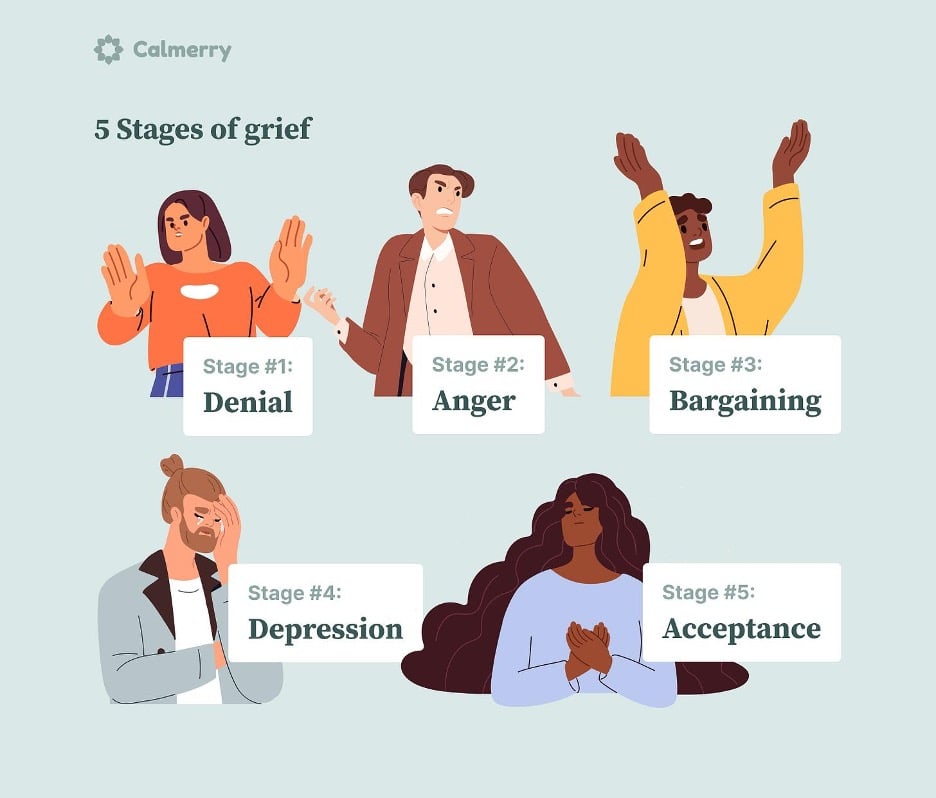
The two-party system is here to stay
More than 1,000 third parties have formed in the US, but few have ever won more than 5% of the vote, and they have typically faded after a few election cycles. The last successful third party in the United States was the Republican Party, which was formed 170 years ago. I tell third-party Sisypheans that theirs would be a strategy worth considering if the Greens or others had a track record of even winning school board or city council seats on a large scale. They don’t. But third parties will always fail in our system without major electoral reform enacted by the two main parties. The first-past-the-post system often results in an unavoidable dynamic in which the Green Party siphons votes from the ideologically similar Democrats, which inadvertently benefits the Republicans, the party ostensibly furthest from the Green Party’s values.
Political parties are not teams: they are arenas of struggle
The Democratic and Republican Parties are often misunderstood as two distinct teams. It’s more accurate to see them as battlegrounds, where various factions continuously compete for influence and dominance. The direction of a political party is determined by the faction that can win more primaries and therefore more seats. The Democratic Party began to shift in a more progressive direction when Bernie Sanders won 43% of the Democratic Party primary vote in 2016 and a historic number of down-ballot progressive primary victories followed. The Republican Party began to shift to the far right when Donald Trump won the Republican Party primary and MAGA-aligned candidates began winning an increasing number of primary elections.
The official “Democratic Party” itself is largely an administrative and fundraising organization. It sets up the infrastructure to run party primaries and does whatever is necessary to win and defeat the other side. Political scientists often think about parties in four categories: government, organization, network, and the voters.
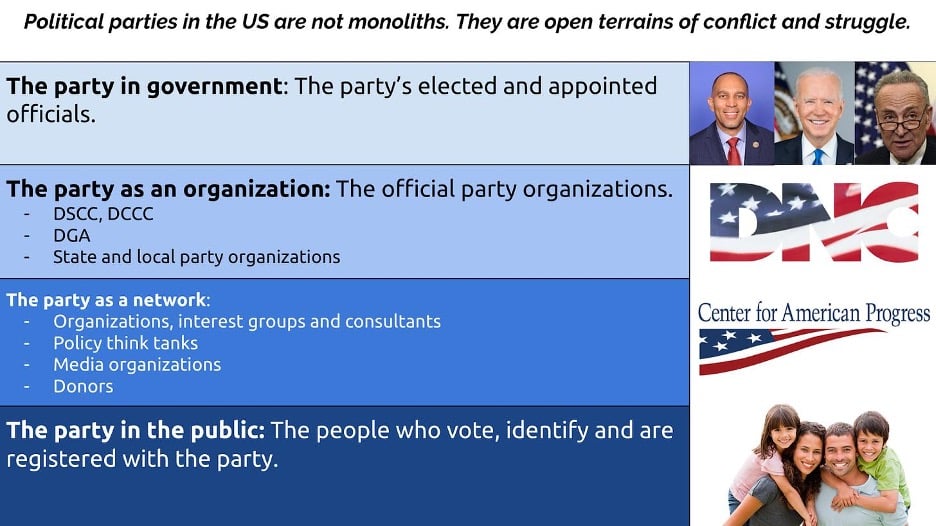
But political parties are notoriously “weak” in the United States compared to parties in most parliamentary systems.
The party in government: The party has limited methods for sanctioning officials who defect from the party line, be they Joe Manchin or Rashida Tlaib.
The party as an organization: The official party organizations have very limited power over who gets nominated, who runs, and how candidates run their campaigns.
The party as a network: The party coalition is heterogeneous and difficult to coordinate. Who decides if you can run as a Democrat or Republican? Well, unlike most parliamentary systems where you have to get official approval from the party before running, in the United States anyone can run in a Democratic or Republican primary.
Factions guide the ideological trajectory of parties
Factions are parties within a political party. You can map them out the same way you would a political party itself.

Factions guide shifts within political parties. Factions are sometimes called “the conveyor belts of ideas.” They inject new ideas into the party to define “the soul of the party.” The party may stand for a few broad things (e.g., affordable health care, climate action, racial justice), but factions are “devils in the details” (Medicare for All, Green New Deal, and police reform).
Factions also shape a party’s direction through election fights that determine the party’s official nominees. Whichever faction is able to organize most successfully to win primaries is the faction with the most influence in the party.
Factions aren’t new. The Radical Republicans were a faction aligned with the abolitionist movement, and they pushed Lincoln to eradicate slavery. They were never the majority of the Republican Party, but they increased their power over time to pull moderates toward them.
How most political change happens
- A social movement shifts public opinion on an issue and/or views among key constituents of a political party.
- A faction within a party takes up the movement’s demands and brings them inside the formal arenas of politics.
- A political party adopts some parts of the demands that can pass into law and help them continue winning elections.
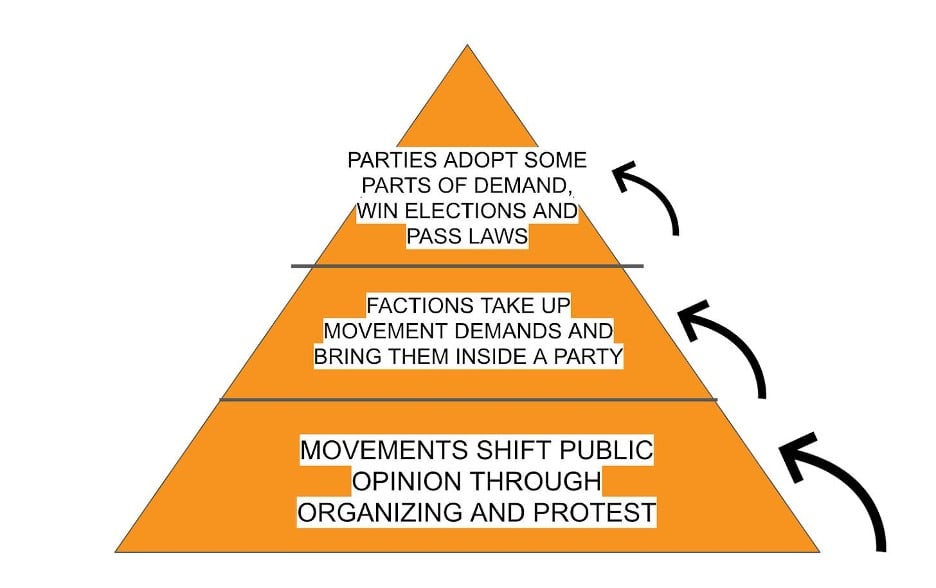
Parties align with movements out of self-interest
Political parties align with movements out of self-interest. In his book When Movements Anchor Parties, political scientist Daniel Schlozman noted, “Parties require resources in order to secure ongoing majorities. Those resources come from other actors, increasingly organized across diffuse ‘party networks’ that link together party organizations, ideologically driven party factions, and pressure groups.” This means that parties seek alliances with movements because movements provide votes, money, and networks that parties need. As the reading highlights, “movement leaders, with the power to direct resources and frame issues, have access to resources that political parties covet but cannot control directly.”
Organizers therefore must build infrastructure that the Democratic Party cannot ignore. This involves organizing voters and volunteers into membership organizations, political donors into established networks, and creating networks of aligned officials, operatives, and organizers who have real political influence.
When movements can demonstrate their ability to organize effectively and sway primary and/or general elections, parties find them attractive allies. “When movements knit together effective organizations, often politicizing face-to-face networks and exploiting new technology, then parties will find them attractive partners,” Schlozman said. “When they fall apart, parties will swoop in, and organize their supporters directly.”
The Democratic Party is a network of anchors
A network of social movements turned interest groups “anchors” the Democratic Party today. Groups rooted in the Black-led civil rights and Latinx-led immigrant rights movements, the labor, reproductive rights, climate and environmental, LGBTQ and gun violence prevention movements, and supporters of Israel, play key roles in the party. They shape its direction and strategy, and spend massive amounts of money to help Democrats beat Republicans in general elections.
Many movements that historically protested the Democratic Party have transformed into its key turnout and donor operations, including labor unions, LGBT rights, and immigrant rights groups. Leaders and groups that succeeded in integrating into the party, like Randi Weingarten and Jim Clyburn, the League of Conservation Voters, the Human Rights Campaign, NARAL, and Everytown USA, have become partisan loyalists.
Movements still outside the Democratic Party’s gates must focus on primaries, conflict, strategic disruption, and demanding policy change in exchange for their support, rather than just choosing between Red and Blue.
The Republican Party is much less likely to embrace the Palestinian cause for structural reasons
Virtually all members of Congress supporting Palestine are younger, progressive Democrats, reflecting the way public opinion shapes political institutions. Most who signed the Ceasefire Now resolution are part of The Squad and Progressive Caucus, representing deep blue urban districts with significant Black, Latinx, young, and liberal populations.
Many of these Democrats were elected with the support of Justice Democrats, an organization that prioritizes Palestine as a core issue. Their alignment with Palestine is driven by ideological commitments to human rights and multiethnic democracy, not simple electoral self-interest.
On the other hand, a recent Pew poll shows stark contrasts: 50% of Republicans support US weapons aid to Israel, compared to only 25% of Democrats. Among white Evangelicals, 61% support such aid, versus just 28% of Black Protestants and 16% of voters under 30. While a few libertarian Republicans like Rand Paul and Thomas Massie oppose AIPAC’s stance, they are exceptions in a GOP that supports Israel mainly due to the influence of Christian Zionists. These Christian Zionists prioritize their religious and Islamophobic commitments to Israel over anti-interventionist or “America First” views.
You can measure a movement’s power by the number of seats it controls or has influence over in Congress. We don’t have much. We have a lot of work to do.
- HR786, Ceasefire Resolution
- 0 Republicans
- 18/213 (8%) of Democrats
- 18/435 (4%) of All Congress
- HR3103, McCollum Bill To Condition Military Funding
- 0 Republicans
- 28/213 (13%) of Democrats
- 28/435 (6%) of All Congress
With major segments of the Republican Party’s electorate including Christian Zionists and xenophobes, the Democratic Party is the primary battleground for Palestinian human rights within the American two-party system. This mirrors the strategy of other social movements—such as those for climate, immigrant rights, reproductive rights, LGBTQ rights, racial justice, and labor unions—that have historically gained influence by navigating the Democratic Party.
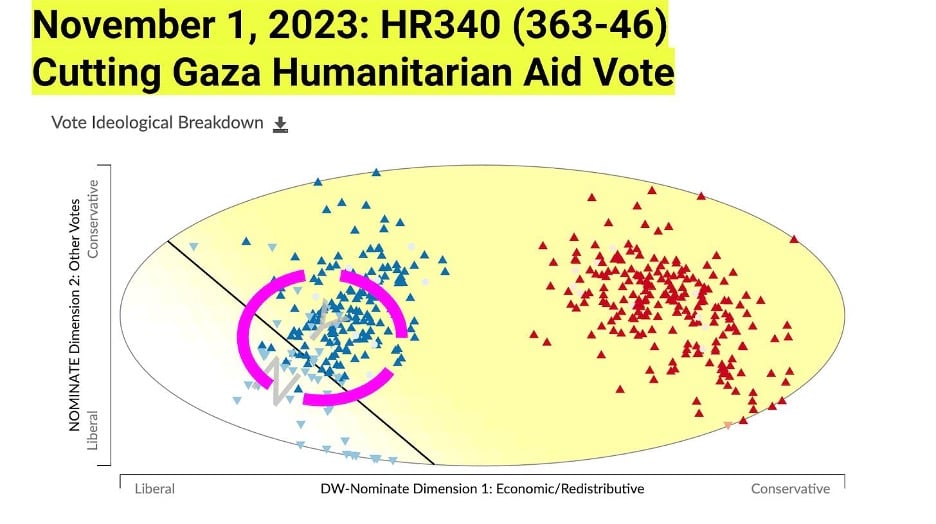
The dividing line between “Yes” and “No” votes on HR40 suggests that the movement’s next step should be to build influence with those just over the line, particularly targeting the Congressional Progressive Caucus, Congressional Hispanic Caucus, and Congressional Black Caucus members beyond The Squad who did not vote “No” on cutting humanitarian aid to Gaza under the guise of fighting terrorism.
The pro-Palestine movement probably needs a Sunrise
A movement’s DNA comprises its story, structure, strategy, and culture. The Sunrise Movement emerged from organizers of the Student Divestment Network and 350.org, who found the DNA of these institutions inadequate for the political moment. At the time, 350 didn’t have a clear orientation guiding its approach to Democratic primary elections and internal party conflicts. Its membership consisted mostly of older, white liberals, and its story focused on shutting down fossil fuels rather than offering a positive vision of job creation. The Student Divestment Network’s strategy centered on the limited tactic of campus divestment, suffered from the “tyranny of structurelessness,” and lacked a persuasive positive vision capable of reaching beyond the choir and beyond an end to fossil fuels.
The leaders who founded Sunrise wanted a different approach. With small grants, including one from 350.org, they engaged in a year of strategic planning, interviewing organizers and participating in various community organizing trainings. They crafted a structure for a mass youth membership, a story centered on a hopeful future with clean energy jobs through a Green New Deal, and a strategy combining nonviolent civil disobedience with electoral organizing to support progressive candidates aligned with their movement. This explicit plan was shared widely, and Sunrise members were trained in organizing as a craft and skill that could be learned and honed.
While not perfect, Sunrise exemplifies a movement organization that was able to anchor itself through building independent political infrastructure capable of waging factional conflict within the Democratic Party. Sunrise mobilized votes, money, and networks of organizers, operatives, and leaders that were hard to ignore.
When Senator Ed Markey trailed his primary opponent Joe Kennedy III by 14 points, Sunrise mobilized an army of creatives, staffers, donors, and volunteer phone bankers to secure his victory. The day after Markey’s primary win, Senator Chuck Schumer’s office reached out to co-sponsor climate legislation, recognizing Sunrise’s influential power with a hope this energy would carry to help Democrats beat Republicans in general elections.
The Sunrise Movement’s political department built crucial ties with labor unions, environmental justice groups, racial justice organizations, and other Gen Z and millennial groups. They organized philanthropy to fund coalitions and candidates, uniting elected officials with labor, social justice, and climate groups. This collaborative approach strengthened the movement, spreading climate action as a key interest across diverse organizations within the Democratic Party ecosystem. Without this coalitional power, movements can struggle to unify diverse interests within a party toward a common cause.
What is to be done?
Abandoning efforts to build influence within the Democratic Party is shortsighted, especially when the pro-Palestine movement’s political infrastructure is still in its infancy. Building influence within the party is crucial for strengthening this foundation, as the pro-Palestine movement’s natural allies are progressive Democrats. To anchor the 96 members of the Progressive Caucus within pro-Palestine politics, the movement must first organize votes, money, and networks to support and grow the progressive faction in party primaries. If the movement cannot defend Reps. Jamaal Bowman and Bush from AIPAC’s primary challenges, it underscores the need to significantly strengthen the political infrastructure that supports candidates like them.
This foundation is essential for advancing the pro-Palestine agenda within the broader political landscape. This work has only recently begun and was largely fueled outside explicit pro-Palestinian organization through the election of the Squad and mobilization of votes, money, and networks by groups like Justice Democrats, Working Families Party, and Sunrise Movement.
Today, the Democratic Party is at a crossroads through a generational divide over the issue of backing and funding Israel’s atrocities in Gaza. The crux of the politics comes down to this:
Establishment Democrats (Biden, Schumer, Pelosi, Jeffries, etc.) view older, long-standing pro-Israel institutions and their leaders as “anchors” essential to the party’s identity and electoral strategy. These anchoring institutions provide the Democratic Party access to networks of donors and voters in exchange for having a seat at the table. Yet, this old guard faces growing challenges from Arab and Muslim Democrats and young Democrats of all backgrounds including many Jews.
There are three potential theories of change here:
- Center-left pro-Israel institutions take a much more active role against US funding of war and occupation.
- Progressives and Arab/Muslim Democrats counterbalance the anchoring weight of center-left pro-Israel institutions within the Democratic Party as pro-Israel politics shift towards the Republican Party;
- The Democratic Party faces electoral risks due to its alliance with Netanyahu’s far-right government, prompting a reevaluation of its stance.
Parties typically form alliances with movements when they perceive electoral gain and when the movements can provide resources like votes, money, and networks. In the Democratic Party, pro-Israel institutions have historically provided these resources, aligning with the party’s goals and securing influence in policy decisions.
The center of the Democratic Party has shifted, and Biden, a master of moving with the center, must now find his footing in a party teeming with dovish Democrats. Change likely hinges on these new groups amassing comparable influence in Democratic Party politics.
I am extremely skeptical of the view that punishing Biden over Palestine through third-party or Republican votes would teach the Democratic Party a lesson. The Democratic Party establishment is notoriously vindictive and such a strategy would not address the longer-term need to build political infrastructure capable of defeating AIPAC in the factional battle within the Progressive Caucus, and then in the Democratic Party at large. Even if it’s hard to believe that Trump could do even more damage to Palestinians than what Biden has already overseen, he can and will. Choose to fight another day by focusing on the infrastructure needed to shape the era and the party’s future—and ensure the damage done won’t be irreversible.
The pro-Palestine movement needs to focus on out-organizing AIPAC within the Democratic Party, and learn from ways other advocacy groups have targeted powerful opponents. Just as Sunrise has worked to limit Big Oil’s influence, health care advocates have challenged Big Pharma, gun rights advocates have taken on the NRA, civil rights advocates have fought Dixiecrats and police unions, immigrant rights advocates have countered xenophobes, and unions have opposed charter schools, the pro-Palestine movement must strategically diminish AIPAC’s power to advance its cause.
Daniel Denvir brought this strategy question to his podcast The Dig in late May, inviting Dylan Saba and me to discuss it. Saba argued that to truly shift the Democratic Party’s stance, we need to dismantle the dominant form of US foreign policy. The US heavily relies on Israel for strategic reasons, as seen in the Abraham Accords, which aim at containing China. I agreed with some of that, noting that anti-AIPAC politics can’t succeed without addressing the broader context of US foreign policy and its alliance with Saudi Arabia. Saba was pessimistic that this could be resolved. To me, there is really no alternative but to organize. Despite the challenges, building a left-liberal coalition for a progressive foreign policy vision within the Democratic Party is essential. Otherwise, we’re kinda just posting through it. It’s a tough road, but necessary for both liberals and the Left to avoid losing ground to the MAGA right.
The Right is exploiting Palestine as a wedge issue to divide Democrats; moderate Democrats are using it to marginalize the party’s left and youth. Over time, this dynamic will likely increase pressure on moderate Democrats to recognize and address the political dynamic, much in the way they’ve had to confront issues related to fossil fuels, the NRA, and charter schools, whose partisans have gravitated away from the Democratic Party and towards the Republican Party.
Neither that movement nor the country’s twenty million black people can win political power alone. We need allies. The future of the Negro struggle depends on whether the contradictions of this society can be resolved by a coalition of progressive forces which becomes the effective political majority in the United States. I speak of the coalition which staged the March on Washington, passed the Civil Rights Act, and laid the basis for the Johnson landslide — Negroes, trade unionists, liberals, and religious groups.
—Bayard Rustin, “From Protest to Politics,” 1965
I wanted to pull out an excerpt from Bayard Rustin’s essay “From Protest To Politics” that might be useful for anti-war and pro-Palestine organizers. The civil rights movement’s push to oust Dixiecrats from the Democratic Party and today’s efforts to diminish AIPAC’s influence are clearly not identical, but Rustin’s insights on elections, social movements, and political parties remain relevant.
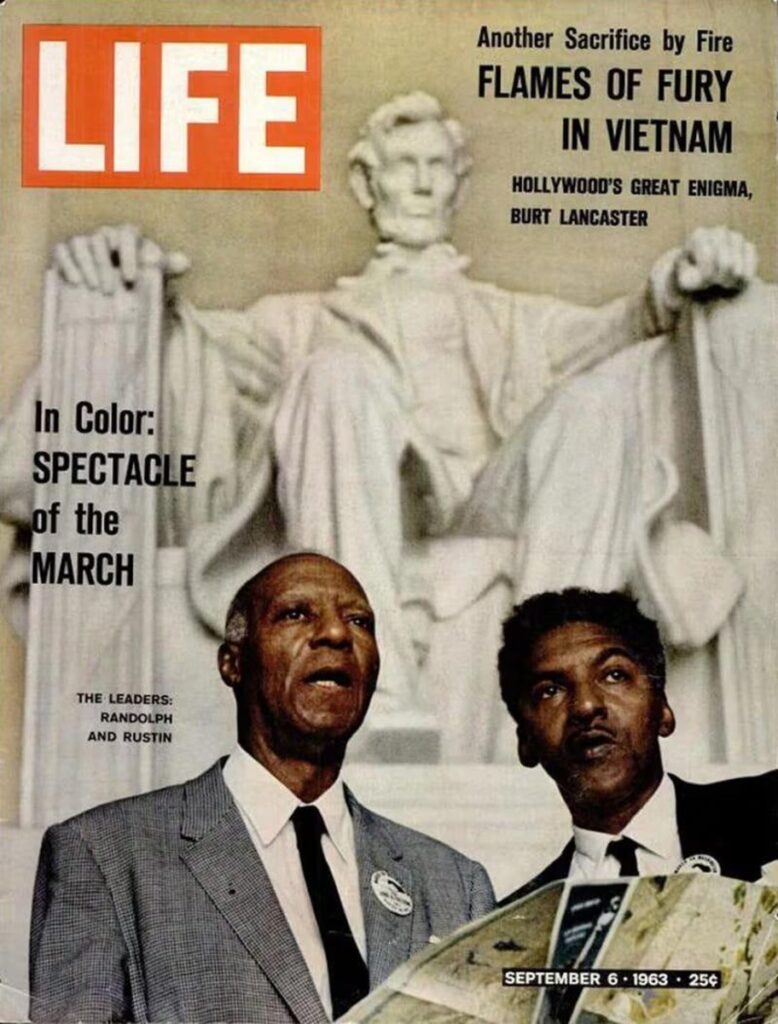
For activists skeptical of electoral politics, Rustin’s suggestion that engaging with political parties doesn’t mean the civil rights movement would ascend into the Democratic Party establishment might not resonate, given the moderating influence the Congressional Black Caucus has recently played within the Democratic Party. It’s important to remember this wasn’t always the case (see the CBC’s relationship to the presidential campaigns of Jesse Jackson or Barack Obama, for instance). Like the laws of gravity, the realities of political parties remain. We can choose to engage with them or ignore them.
To explore the full dynamics of coalitions and political power, one must consider the scenarios under which AIPAC’s influence could significantly diminish or leave the Democratic Party. This could occur if one or more of the following events transpire:
- Center-left, Zionist, pro-Israel institutions like J Street take a much more active role organizing money, votes, and networks against AIPAC’s influence in the Democratic Party (this year, J Street has played a neutral role while Jewish Democratic Council of America has aligned with AIPAC as they spend millions in Republican donor money against progressive Democrats critical of the Israeli government).
- The mobilization of money, votes, and networks by Arab and Muslim Democrats and/or younger, progressive Democrats surpasses the efforts of pro-Israel organizations. A notable rise in the influence of these groups could form a substantial counterforce to AIPAC’s sway, thereby redefining the priorities and policies of the Democratic Party, but it likely would have to look something a bit more like the DREAMer or Sunrise Movement.
- AIPAC and its brand of extreme pro-Israel politics become so divisive within the Democratic Party that they experience a significant shift in alignment, similar to other once-prominent interest groups. Just as Big Oil, the NRA, and even charter schools have gradually migrated towards the Republican Party, AIPAC’s influence could wane within Democratic ranks.
Here’s the most important excerpt from Rustin on the strategy to withhold votes for political leverage:
Some who take this position urged last year that votes be withheld from the Johnson-Humphrey ticket as a demonstration of the Negro’s political power. …Thus coalitions are inescapable, however tentative they may be…
—Bayard Rustin, “From Protest to Politics”
The issue is which coalition to join and how to make it responsive to your program. Necessarily there will be compromise.
But the difference between expediency and morality in politics is the difference between selling out a principle and making smaller concessions to win larger ones. The leader who shrinks from this task reveals not his purity but his lack of political sense.
Rustin’s insights reveal that elections are fundamentally about choosing coalitions, not just casting votes. He recognized that while coalitions require compromise, the key is to make strategic concessions without abandoning core principles. Rustin, a master organizer, balanced moral clarity with political pragmatism, always with a focus on building powerful institutions and campaigns that the political establishment could not ignore.
Rustin’s remarks remind me of these observations from Daniel Scholzman about how social movements go from the margins of public opinion toward winning policy outcomes:
Movements join with political parties only on terms acceptable to winning coalitions inside those parties. Political parties want to win election. Otherwise, the politicians and interests that constitute them have no hope of wielding power or setting policy. And pragmatists inside party coalitions know this lesson best of all.
—Daniel Schlozman, When Movements Anchor Parties, pp. 5-6
Parties accept alliance only with the support of a winning coalition inside the party, including hard-nosed realists as well as ideological sympathizers. If the movement threatens the pragmatists’ core interests, whether electoral or pecuniary, then the party seeks other paths to majority. No movements that meet the terms parties set, no alliance.
If parties believe that movement radicals imperil their electoral prospects, then movement moderates must jettison their brethren if they want to sustain alliance with a major party.
Anchoring groups pay a high price to join together with parties. Yet given the rules of the game, it is a price well worth paying.
Featured image: Montage including the Ricardo Levins Morales poster “We Are the Mainstream.”
Did you enjoy this article?
We're in the middle of our annual fund drive, and this year we're building our own internal infrastructure for subscriptions, meaning more of every dollar pledged goes to . Subscribe today to support our work and be a part of Convergence's next evolution.

